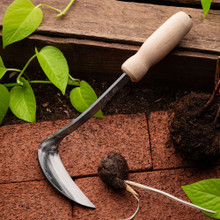- Home
- Vegetable Gardening for Beginners
- Gardening Tools
Essential Gardening Tools
for Vegetable Gardening
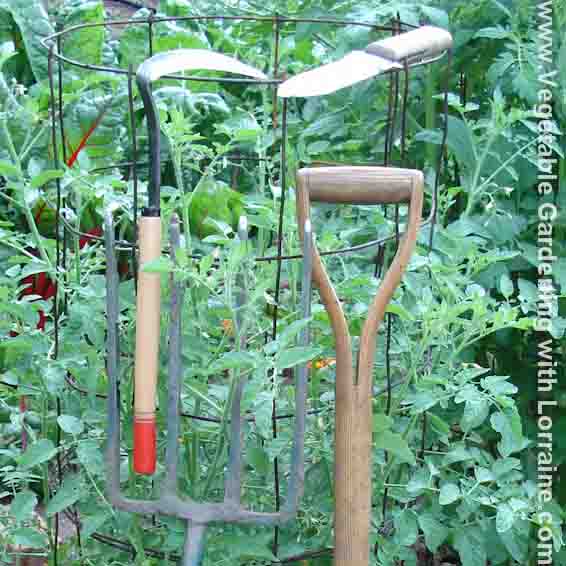
There are tons of sites out there selling gardening tools, and it can be a challenge to know what's really good without buying it and trying it. I can tell you which have stood the test of time for me - which tools I have found to be truly indispensable. Everything I recommend on this website comes from personal experience and the tools I recommend here are worth every penny.
I do virtually all my vegetable gardening work with the following seven gardening tools - and most of it with the first two. None of them are cheap, but I've worn out and busted enough cheap tools for both of us, and if you're serious about vegetable gardening, buying quality will not only pay for itself over and over, you'll enjoy your gardening more. I've learned this by being old: cheap is more expensive when viewed backwards through time.
Indispensable Vegetable Gardening Tools
for In-Ground Gardens
Forged digging fork First a few words about "forged": there is a crucial difference between a hand-forged, integral-socket digging fork, and the stamped steel variety found in virtual all hardware stores and Home Depot-type places. Hardware store variety forks just DON'T hold up. When I first met Tito, he was using a new Ace fork, which he broke the handle on. He bought another just like it, and this time the whole forkhead fell out of the handle, because the little tang was just wedged into the wood.
A forged-steel garden fork or spade is made by hammering red-hot steel into the desired shape. The process lines up the steel grains in a way that makes the steel WAY stronger than cold-stamped steel, both in terms of resistance to bending, and the strength of its attachment to the handle. The fork head and socket are one integral piece. I've been using mine for 35 years (as of 2020 - how time flies). These spades and forks have been made in the same forge in Lancashire, England since 1780.
When you stand on this classic gardening tool, all the force you exert gets transferred to the job at hand rather than wasted in deflecting the head or torquing the handle. If you're digging for ten minutes this probably won't be so noticeable, but if you're digging for two hours it can exhaust you.
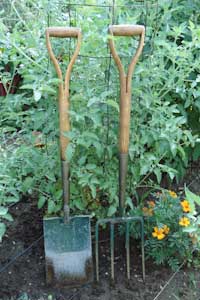
The digging fork is necessary for proper soil preparation. Most folks don't realize that rototillers are actually really bad for the soil. Not only do they chew the soil surface structure completely to powder, they create a hardpan just below the depth of the tiller, which makes plant roots turn sideways when they hit the hardpan rather than being able to grow straight down into the soil.
As tilling destroys the soil structure it also destroys the soil life. What looks to you and I like nice fluffy loose soil, looks to the tiny critters that live there as though their home has just been run through a blender. Why does that matter? Because those organisms cycle the nutrients that become our nutrition. (For more on this, you can read Plowman's Folly by Edward Faulkner, written in 1943, or The Intelligent Gardener by Steve Solomon.)
So it is much better to gently loosen soil by hand with a spade and fork and incorporate your compost that way, than it is to pulverize your soil with a tiller. Whether you choose to single dig or double dig your soil, a fork is necessary.
I also use my fork, in conjunction with the spade, when I'm removing sod to expand a garden bed, and for lifting potatoes and carrots in the fall. (Get the digging fork, not the smaller border fork.) Clarington Forge gardening tools go by the brand name Bulldog Tools.
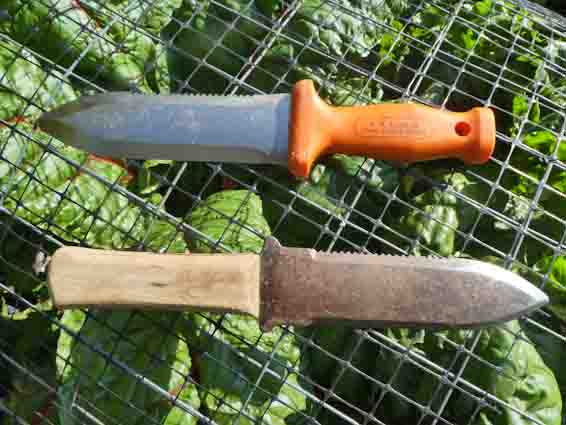 My Beloved Old and New Hori Hori
My Beloved Old and New Hori HoriJapanese Gardening Knives
Japanese gardening knife This little gem does everything else. Throw away every trowel you've ever owned. Throw away that little snaketongue-on-a-stick thing that you try to weed dandelions with. Throw away your bulb planter. Throw away your little three-tined weed thingy that never worked anyway. This one tool will NEVER bend or break (extremely hard steel), is just the right width, shape and sharpness to do all the jobs listed above, and more jobs that you haven't thought of yet. It replaces a bucketful of other gardening tools. My friend Ralph calls it a "Speedy Rabbit" because of the tool manufacturer's logo, but I call it a Speedy Rabbit because it chews out deep-rooted weeds so easily. It's not sharp enough to cut much of anything, but it is rigid and sharp enough to penetrate even clay soils. The Japanese name for this tool is "hori hori", which means "diggy diggy". Kinda cute, huh?
Note 2020: I misplaced my 30-year old hori hori this spring and I was bereft! I just couldn't function without it - so I bought a new one, stainless, with a bright orange handle from AM Leonard. It's Italian made, and totally rocks! Then I found my beloved old one under a flopped-over chard. You come to love a worthy tool after 30 years of faithful service, and I'm so happy my old friend is back in my hand. But I now love and use them both. The orange-handled one is just as easy to use, but a lot harder to lose.
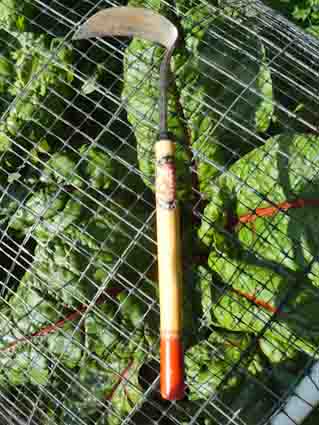 My Beloved Old Japanese Weeding
My Beloved Old Japanese WeedingSickle (aka Nejiri Kama)
Japanese weeding sickle I have tried every hoe there is. The standard hoe. The pull hoe. The triangle hoe. The circle hoe. The scuffle hoe. Hoe hoe hoe... until a few Christmases ago. I got a little Japanese weeding sickle that you pull toward you about a quarter-inch below the surface of the soil, and it is so razor sharp that it cuts the weed roots right off, cleanly. By far and away the best weeding tool I've ever used. The Japanese do hardened steel like no one else. The darn thing is still razor sharp after several seasons of cutting roots and hitting bits of rock.
Pruners I use these for pruning the raspberries, harvesting some things, and keeping the landscape surrounding the vegetable garden under
control. Lilacs and Virginia creeper are always looking to take over
undefended territory, and my Felco #2 pruners are my weapon of choice. Mine are about twenty
years old and going strong. I do lube 'em up with WD40 once in
awhile. A necessity even if not used every day, they deserve a place in your gardening tool bucket.
Forged square garden spade The standard, long-handled, round-nosed shovel used in construction for schlepping sand and cement doesn't work well in the garden. The difference needs to be experienced - it is difficult to describe. When "cutting an edge" on a bed or lawn, double or single digging in heavy soil - the D-handled, square-blade, forged garden spade is THE tool.
They do not deflect when you stand on them, and stand on them you will when doing initial soil preparation. These shovels are rigid, so you can work them back and forth in the soil when loosening a shovelful. Used in conjunction with a spading fork.
To see them in use, visit the French Intensive, Double-Dug Raised Bed article, where there is a You Tube video.
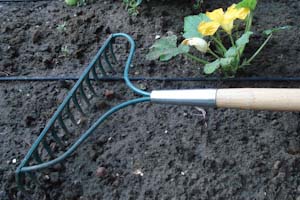
Level rake This is not a leaf rake, but the stubby metal-toothed kind that looks a bit like a big comb on a handle. I use it after single or double digging to level the finished bed. I don't use this tool a lot, but it's the only tool that will do this specific job.
Watering Wand Our vegetable garden is on drip-tape irrigation, but I have a ton of flowers and vegetables in pots, hanging baskets, and upside-down planters that need watering by hand. I have a Dramm high volume, low pressure watering wand that I call my Magic Wand. It's the bees knees of watering tools, and the solid brass shutoff never leaks. It is the best for watering newly-planted seed flats, because the flow is so gentle it doesn't disturb the seeds. You don't need the fancy spin-head multi-choice spray pattern gizmos for gardening. In my experience the other kind always ends up leaking and drips down your arm and into your shoes.
Very Useful, But Not Indispensable, Tools
Compost fork For decades I used my digging fork for turning the compost. Last year I responded to an online ad from Clarington Forge, and treated myself to a compost fork. Now I don't know how I ever lived without this tool! It is much lighter (don't use it for digging!) and has much sharper tines than the digging fork, which makes it SO much easier to turn the compost. It halves the time it takes, and uses less body energy. I love this tool!
Loppers These come in two main varieties: bypass (which work like scissors) and anvil (which work like a knife against a cutting board). Some folks swear by one over the other. I like the anvil type, because it's too easy for the bypass ones to deflect and spread apart when being asked to cut an old dead lilac stalk. But some people say the same thing about the anvil kind. Personal preference, I guess. Either way, they're great for branches too big for the hand pruners.
Bow Saw And for even bigger branches I use a cheap (yes, I did use the C word - 'cause I don't use 'em much) landscaper's bowsaw from Home Depot. Not really under the category of vegetable gardening tools, but useful for shrub removal when necessary. And while I haven't used it myself, Garrett Wade's Folding Pruning Saw is going to be my high-quality, durable choice when my crappy one craps out.
It Seemed Like a Good Idea at the Time...
The circle hoe was the first gizmo that doused the flame of my gardening tool lust. I'd read such great things about it: you can get right in close to the base of your vegetables without damaging their roots. That's true. You won't damage anybody else's roots either, except the ones in about a half-inch area right at the front of the hoe. Don't waste your money.
Garden Weasel works for loosening the top 3 inches of soil - if the soil is already loose. Toss this out of our gardening tool bucket to make room for something actually useful. (But... their ergonomic level rake looks interesting... hmmm..... might just have to try that out...)
Help share the skills and spread the joy
of organic, nutrient-dense vegetable gardening, and please...
~ Like us on Facebook ~
Thank you... and have fun in your garden!
Affiliate Disclaimer
This website contains affiliate links to a few quality products I can genuinely recommend. I am here to serve you, not to sell you, and I do not write reviews for income or recommend anything I would not use myself. If you make a purchase using an affiliate link here, I may earn a commission but this will not affect your price. My participation in these programs allows me to earn money that helps support this site. If you have comments, questions or concerns about the affiliate or advertising programs, please Contact Me.Contact Us Page




